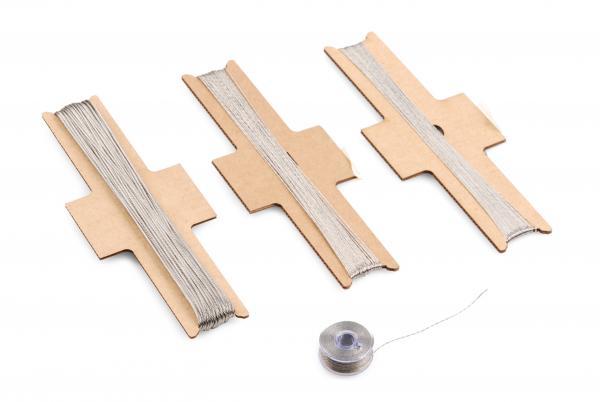Sew with conductive thread
Sew a simple fabric circuit using conductive thread, an LED, and a coin cell battery to create a lit patch and learn basic electronics.



Step-by-step guide to sew a simple fabric circuit with conductive thread
Make a Conductive Sewing Bracelet
Step 1
Gather all the materials on a clean table so everything is ready.
Step 2
Lay the fabric flat and use the marker to draw a small circle for the battery and a tiny dot 1–2 cm away for the LED and two separate lines connecting them for the positive and negative traces.
Step 3
Cut about 60 cm of conductive thread and thread the needle then tie a small knot at the end.
Step 4
Sew the positive trace by making small tight running stitches along the positive line from the battery circle to the LED dot and finish with a backstitch to secure the end.
Step 5
Cut a second 60 cm length of conductive thread and thread the needle then tie a small knot at the end.
Step 6
Sew the negative trace by making small tight running stitches along the negative line from the battery circle to the LED dot and finish with a backstitch to secure the end.
Step 7
Place the LED so the longer leg (positive/anode) lines up with the positive stitched pad and the shorter leg (negative/cathode) lines up with the negative stitched pad.
Step 8
Wrap and stitch the longer LED leg into the positive stitched pad with several tight wraps so the metal leg touches the conductive thread and tie off close to the fabric.
Step 9
Wrap and stitch the shorter LED leg into the negative stitched pad with several tight wraps so the metal leg touches the conductive thread and tie off close to the fabric.
Step 10
Slide the coin cell battery into the battery circle so the + side of the battery touches the positive trace and the - side touches the negative trace and press it down firmly.
Step 11
Cover the battery with the small felt scrap or fabric tape to hold it in place and to prevent the two traces from shorting if they touch.
Step 12
Press the LED area gently and look to see if the LED lights; if it does not light ask an adult to help check that the LED legs and battery contacts are snug against the conductive thread.
Step 13
Share a photo or video of your glowing fabric patch on DIY.org so everyone can see your cool circuit.
Final steps
You're almost there! Complete all the steps, bring your creation to life, post it, and conquer the challenge!


Help!?
If I can't find conductive thread or the exact coin cell, what can I use instead?
If you can't get conductive thread, use thin adhesive copper tape for the positive and negative traces and press the LED legs onto the tape instead of stitching, and if you don't have that coin cell try a compatible button cell like CR2025 while ensuring the + side touches the positive trace.
My LED doesn't light after I sew it — what should I check?
Check that the longer LED leg lines up with the positive stitched pad and the shorter with the negative, that both LED legs are wrapped tightly into their stitched pads, the + side of the coin cell is contacting the positive trace, and the felt scrap or fabric tape isn't shorting the two traces.
How can I adapt the steps for younger or older kids?
For younger kids pre-draw the battery circle/dot and traces and pre-thread short 60 cm pieces of conductive thread so they only do running stitches and wrap the LED legs, while older kids can stitch longer decorative traces, add a sewn switch, or branch extra 60 cm threads to power multiple LEDs.
How can we extend or personalize the glowing fabric patch after it works?
Extend it by sewing branching positive and negative traces with extra 60 cm lengths of conductive thread to add more LEDs in parallel, add a small sewn snap as a switch, and decorate or conceal the coin cell with the felt scrap or fabric tape for a finished look.
Watch videos on how to sew a simple fabric circuit with conductive thread
Learn to Sew with Debbie Shore, Kids! Lesson 1
Facts about e-textiles and basic electronics
⚡ To keep your fabric circuit working, sew separate paths for the positive and negative sides so the threads don’t accidentally touch and short.
🔋 A common coin cell (like a CR2032) provides about 3 volts and can power a small LED for hours depending on how bright it’s driven.
🧵 Conductive thread is made with tiny metal strands so your stitches can carry electricity and still bend with fabric.
👗 E-textiles and wearable tech show up in fashion and art — designers have made glowing dresses and light-up costumes using tiny circuits.
💡 LEDs are super-efficient — they make lots of light using very little power, which is perfect for coin-cell powered patches.
How do you sew a simple fabric circuit with conductive thread, an LED, and a coin cell?
What materials do I need to make a sewn fabric circuit with conductive thread?
What ages is sewing a simple conductive-thread fabric circuit suitable for?
What safety tips and benefits should I know about conductive-thread sewing projects?


One subscription, many ways to play and learn.
Only $6.99 after trial. No credit card required



